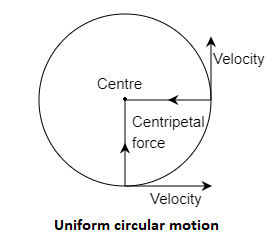
Define uniform circular motion.
Answer
528.3k+ views
Hint:Uniform circular motion means that the particle or an object or a body which moves or travels in the circular path, with the uniform acceleration. Uniform acceleration is the acceleration of the object or body or a particle is constant. There is no increase or decrease of the acceleration.
Complete step by step solution:
The movement of the body or object or a particle, that is following a circular path is called a circular motion. Now, the motion of a body or object or a particle moving with constant speed along a circular path is called Uniform Circular Motion. Here, the speed is constant but the velocity changes. If the particle is moving in the circular path, then it has some acceleration due to centripetal force acting towards the centre which is making it move in the circular path. Hence, the acceleration is perpendicular to the velocity of the particle at every instant, so the velocity of the direction keeps changing but not the magnitude. So, the motion is called uniform acceleration motion.

Some examples of the uniform circular motion are, motion of the electron around the nucleus of the molecule. The motion of the blades of the windmill, the motion of the blades of the fan until the speed is changed manually, the motion of the satellite around the earth and the motion of the satellite around the moon. These are the real time examples of the uniform circular motion.
Note: The tangential speed at every point on the circumference is found to be constant in a uniform circular motion, and the tangential velocity vector is tangent at every point over the circumference. Tangential velocity is the vector formed to the tangential speed; therefore, the magnitude remains constant and equal to the tangential speed of the uniform circular motion.
Complete step by step solution:
The movement of the body or object or a particle, that is following a circular path is called a circular motion. Now, the motion of a body or object or a particle moving with constant speed along a circular path is called Uniform Circular Motion. Here, the speed is constant but the velocity changes. If the particle is moving in the circular path, then it has some acceleration due to centripetal force acting towards the centre which is making it move in the circular path. Hence, the acceleration is perpendicular to the velocity of the particle at every instant, so the velocity of the direction keeps changing but not the magnitude. So, the motion is called uniform acceleration motion.

Some examples of the uniform circular motion are, motion of the electron around the nucleus of the molecule. The motion of the blades of the windmill, the motion of the blades of the fan until the speed is changed manually, the motion of the satellite around the earth and the motion of the satellite around the moon. These are the real time examples of the uniform circular motion.
Note: The tangential speed at every point on the circumference is found to be constant in a uniform circular motion, and the tangential velocity vector is tangent at every point over the circumference. Tangential velocity is the vector formed to the tangential speed; therefore, the magnitude remains constant and equal to the tangential speed of the uniform circular motion.
Recently Updated Pages
Basicity of sulphurous acid and sulphuric acid are

1-on-1 Online Tuition for Cambridge IGCSE Success in 2025-26

1-on-1 Online Tuition: Help Your Child Excel in Exams 2025-26

Maximize Study Time with Personalized Online Tuition 2025

Best 1-on-1 Online Tuition for CBSE Science Class 8 (2025)

Master English: Essays, Grammar, Writing & Learning Tools

Trending doubts
1 ton equals to A 100 kg B 1000 kg C 10 kg D 10000 class 11 physics CBSE

Knock knee syndrome is caused by A Fluoride pollution class 11 biology CBSE

Difference Between Prokaryotic Cells and Eukaryotic Cells

One Metric ton is equal to kg A 10000 B 1000 C 100 class 11 physics CBSE

1 Quintal is equal to a 110 kg b 10 kg c 100kg d 1000 class 11 physics CBSE

Proton was discovered by A Thomson B Rutherford C Chadwick class 11 chemistry CBSE




